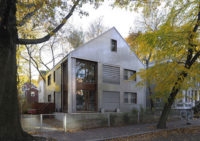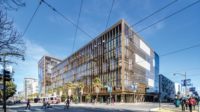Attribute it to empty-nest syndrome, falling crime rates, or rising gas prices: suburbanites are downsizing to apartments and condos located near theaters and cafes on walkable downtown blocks in San Diego, Milwaukee, Atlanta, and other cities nationwide.


Big-box retailers are in hot pursuit, eager to grow beyond their longtime suburban locations to tap these emerging markets. But the traditionally sprawling floor plates of these stores aren’t a good fit for densely settled urban areas. So, architects are laying them out more up-and-down than left-to-right—with more floors, less parking, fewer signs, and more glass facades—even if that means breaking with the look that once helped define the store’s brand. “Big-box retailers across the country are becoming substantially more flexible about what kind of box they can use,” says John Bemis, an Atlanta-based director of Jones Lang LaSalle Retail, a national real estate firm.
A decade ago, one percent of big-box stores were in cities, but today that figure is up to five percent—about 90 current stores, with more planned—Bemis says, “and future growth will be exponential from here on in.” Going vertical means making do with less square footage. For example, Circuit City’s new “The City” format, designed in-house, shrinks its size by 42 percent, to 20,000 square feet from 34,000 square feet; 18 were open by March, says Jim Babb, a company spokesman.
Making sure that size reductions don’t result in the loss of too many signature interior design details can be a tough task for architects. Eric Lagerberg, a principal of Callison, the Seattle-based firm, recently completed a prototype for Cabela’s, the outdoors outfitter, whose new 85,000-square-foot two-level stores will measure less than half of their 200,000-square-foot one-level forerunners. However, the prototype retains Cabela’s distinct Adirondack-cabin mien. Interior ponds, now smaller, will be consolidated into one corner; taxidermy pieces will glower closer to the front door. Though they’re shedding muntins, windows will still have heavy wood frames, and entry gables will replace porte-cocheres. “I had to decide what was important and how important was it,” Lagerberg says. “There still needs to be continuity across the whole.”
Even if a store looks the part, though, its multiple levels can put off customers used to shopping with carts, retailers say. Architects for Target faced that problem at the department store’s year-old outpost in Glendale, California, which at three stories is the chain’s tallest. Their solution was to reconfigure the escalator banks in the 180,000-square-foot facility, which formerly housed a Robinsons-May department store. There are still traditional sets of moving stairs for people, but next to them runs a special dedicated lift system for carts. Also, store officials point out, the russet-colored glass-block-detailed building also benefits from parking-garage entrances on two floors, which helps funnel customers to the store’s upper reaches, says Eames Gilmore, an in-house architect. “We needed to make sure the entrances were intuitive,” he said.
Luring people to the store can be made easier if it’s not set back from the street, so as to better catch their eyes, says John Clifford, a principal at the firm GreenbergFarrow. With that in mind, Clifford is eliminating a plaza outside an Atlanta office tower in order to extend the building’s two-story ground-level retail berth toward a major thoroughfare. The design, which enlarges the retail space from 20,000 square feet to 50,000 square feet, also calls for a 40-foot glass facade, he says. Those features should help the owner attract a big-box tenant, which would replace the shoeshine business and dry cleaners currently inside, Clifford adds.
Not every big-box is seeking out cities. Ikea, the Swedish furnishings store, for instance, has largely avoided urban areas, viewing on-site parking as fundamental to its business plan. Even its new outpost in Red Hook, Brooklyn—its first New York City store, and another GreenbergFarrow project—manages to squeeze in a parking lot. “The idea is you buy a chair, carry it out, put it in your car, drive it home, and put it together yourself,” Clifford says. “That’s why we can sell it to you for $14.”



